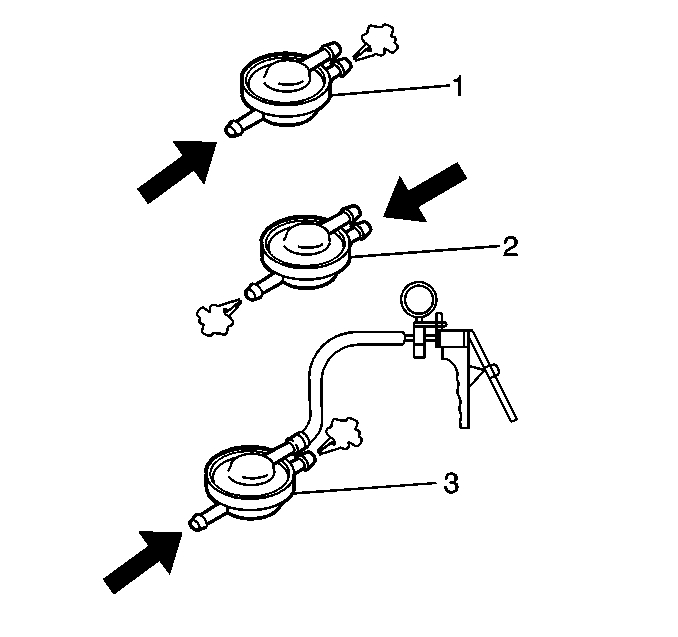Evaporative Emission (EVAP) Canister Purge System Inspection
Caution: Do not breathe the air through the EVAP component tubes or hoses. The fuel vapors inside the EVAP components may cause personal injury.
Important: Perform a careful visual inspection of the Evaporative Emission (EVAP) system components and connecting hoses before diagnosis of an EVAP system malfunction.
Important: The EVAP canister purge system does not perform purging (vacuum is not detected at the purge hose) unless the engine is sufficiently warmed up and the Heated Oxygen Sensor (HO2S) is fully activated. When the purge hose is disconnected as in step 6, some air may be drawn into the purge line. As a result, the PCM might detect a change in the purge gas concentration and stop purging. This is a normal action and may be the cause of a failure to detect vacuum in step 7. If no vacuum is felt in step 7, continued testing of the EVAP system may be necessary to avoid replacement of good parts.
Failure of the Evaporative Emission (EVAP) Canister Purge System to pass any of the above checks indicates a possible malfunction that will require further inspection.- Allow the engine to cool to room temperature.
- Start the engine (cold).
- Disconnect the purge hose from the EVAP canister.
- Place a finger against the end of the disconnected hose and check for vacuum. Vacuum should not be felt when the engine is below normal operating temperatures.
- Connect the purge hose to the EVAP canister and warm the engine up to normal operating temperature.
- Disconnect the purge hose from the EVAP canister.
- Place a finger over the disconnected hose and check for vacuum. Vacuum should be felt with the engine running at normal operating temperature.
Evaporative Emission (EVAP) Canister Inspection
- Disconnect the vacuum hoses from the EVAP canister.
- Blow air into the tank pipe of the EVAP canister. There should be no restriction of air flow through the purge pipe and the air pipe.
- Replace the EVAP canister, if the EVAP canister fails the above check.
- Connect the vacuum hoses to the EVAP canister.

Evaporative Emission (EVAP) Canister Purge Valve Inspection
- Disconnect the EVAP Canister Purge Valve electrical connector.
- Using a DMM (1), measure the resistance of the EVAP Canister Purge Valve (2) between both terminals. The resistance should be 28 to 36 ohms at 20°C (68°F).
- Replace the EVAP Canister Purge Valve if the resistance is not 28 to 36 ohms at 20°C (68°F). If the resistance is within specification, proceed to step 4.
- Disconnect the EVAP Canister Purge Valve vacuum hoses from the intake manifold and the vacuum pipe (from EVAP canister).
- Blow air into the EVAP Canister Purge Valve vacuum hose that was disconnected from the vacuum pipe. Air should not pass through the EVAP Canister Purge Valve and exit from the intake manifold hose.
- Connect 12 volts DC to the EVAP Canister Purge Valve terminals.
- Blow air into the EVAP Canister Purge Valve vacuum hose that was disconnected from the EVAP canister. Air should pass through the EVAP Canister Purge Valve and exit from the intake manifold hose.
- Replace the EVAP Canister Purge Valve, if the EVAP Canister Purge Valve failed this inspection.
- Reconnect the EVAP Canister Purge Valve vacuum hoses and electrical connector.
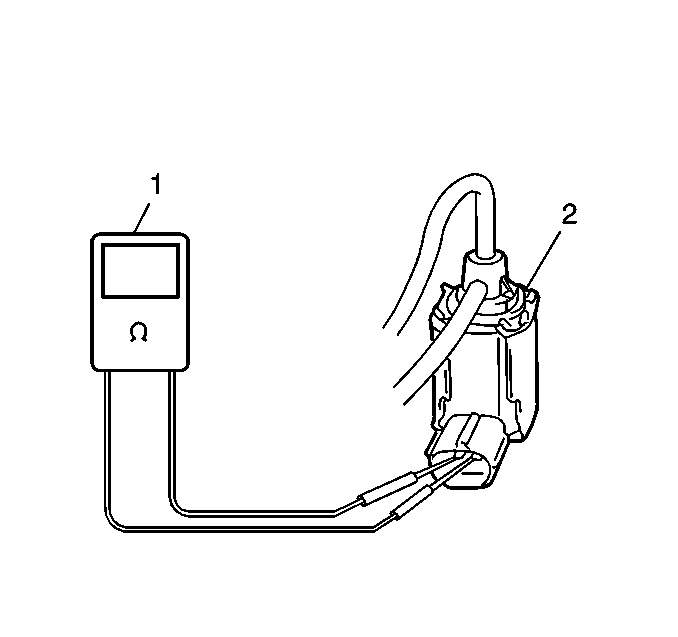
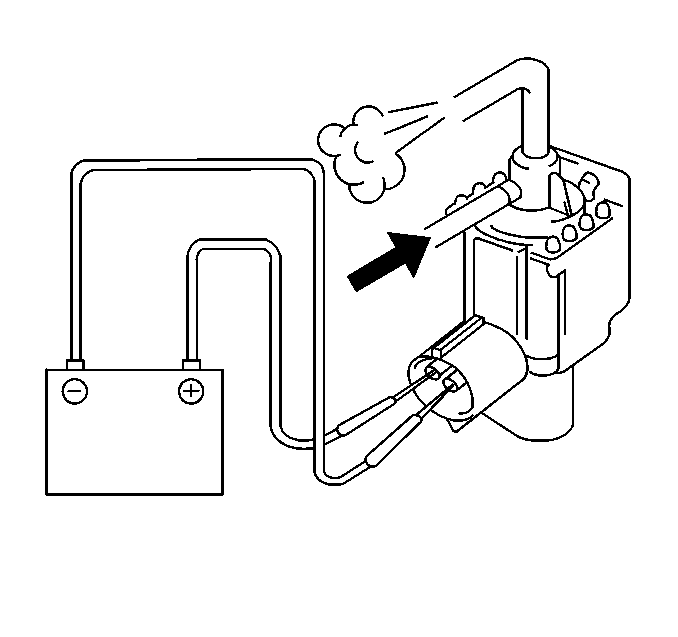
Evaporative Emission (EVAP) Canister Vent Solenoid Inspection
- Disconnect the EVAP Canister Vent Solenoid valve electrical connector.
- Using a DMM, measure the resistance of the EVAP Canister Vent Solenoid valve between both terminals. The resistance should be 25 to 30 ohms at 20°C (68°F).
- Replace the EVAP Canister Vent Solenoid valve if the resistance is not 25 to 30 ohms at 20°C (68°F). If the resistance is within specification, proceed to step 3.
- Disconnect the EVAP Canister Vent solenoid hose from the EVAP canister.
- Blow air into the EVAP Canister Vent Solenoid hose that was disconnected from the EVAP canister. Air should pass through the EVAP Canister Vent Solenoid.
- Connect 12 volts DC to the EVAP Canister Vent Solenoid terminals.
- Blow air into the EVAP Canister Vent solenoid vacuum hose that was disconnected from the EVAP canister. Air should not pass through the EVAP Canister Vent Solenoid and exit from the other end.
- Replace the EVAP Canister Vent Solenoid, if the EVAP Canister Vent Solenoid failed this inspection.
- Reconnect the EVAP Canister Vent Solenoid valve vacuum hoses and electrical connector.

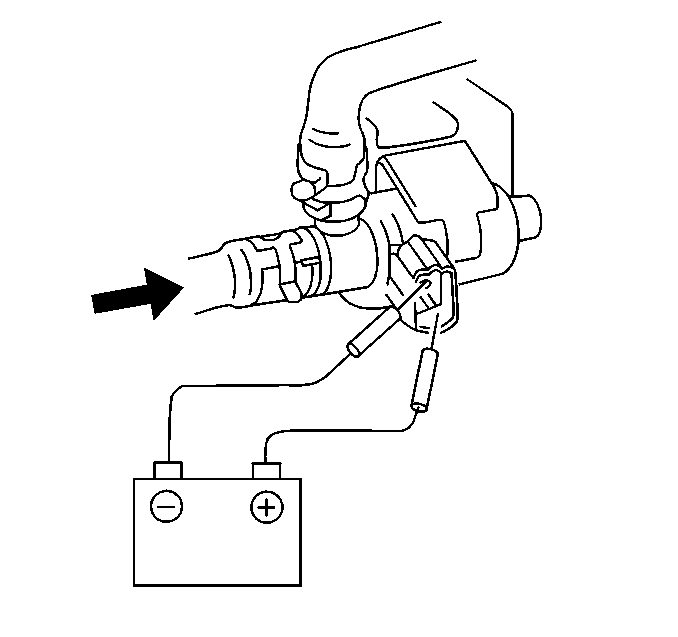
EVAP Tank Pressure Control Solenoid Vacuum Valve Inspection
- Disconnect the EVAP Tank Pressure Control Solenoid vacuum valve electrical connector.
- Using a DMM, measure the resistance of the EVAP Tank Pressure Control Solenoid vacuum valve between both terminals. The resistance should be 28 to 36 ohms at 20°C (68°F).
- Replace the EVAP Tank Pressure Control Solenoid vacuum valve if the resistance is not 28 to 36 ohms at 20°C (68°F). If the resistance is within specification, proceed to step 4.
- Disconnect the EVAP Tank Pressure Control Solenoid vacuum valve vacuum hoses from the intake manifold and the vacuum pipe (from the Tank Pressure Control valve).
- Blow air into the EVAP Tank Pressure Control Solenoid vacuum valve vacuum hose that was disconnected from the vacuum pipe. Air should not pass through the EVAP Tank Pressure Control Solenoid vacuum valve and exit from the intake manifold hose.
- Connect 12 volts DC to the EVAP Tank Pressure Control Solenoid vacuum valve terminals.
- Blow air into the EVAP Tank Pressure Control Solenoid vacuum valve vacuum hose that was disconnected from the vacuum pipe. Air should pass through the EVAP Tank Pressure Control Solenoid vacuum valve and exit from the intake manifold hose.
- Replace the EVAP Tank Pressure Control Solenoid vacuum valve, if the EVAP Tank Pressure Control Solenoid vacuum valve failed this inspection.
- Reconnect the EVAP Tank Pressure Control Solenoid vacuum valve vacuum hoses and electrical connector.
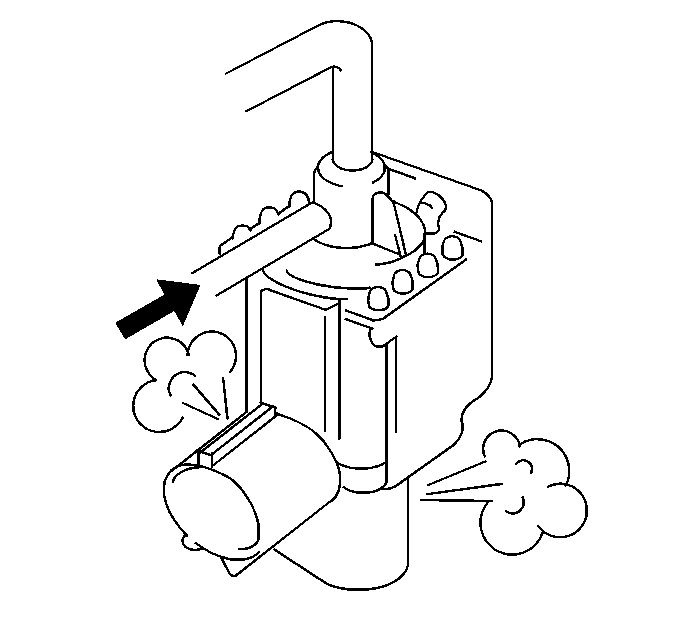

Tank Pressure Control Valve Inspection
- Connect a length of the hose to the Fuel Tank Pressure Control valve vacuum port marked TANK.
- Blow hard into the hose. Air should pass slowly through to the side marked CAN of the Fuel Tank Pressure Control valve (1).
- Remove the hose from the TANK side and connect it to the CAN side of the Fuel Tank Pressure Control valve.
- Blow easily into the hose. Air should pass through to the side marked TANK of the Fuel Tank Pressure Control valve (2).
- Use a J 23738-A hand vacuum pump in order to apply the vacuum to the vacuum port.
- With vacuum applied, blow into the hose marked TANK. Air should pass easily through to the side marked CAN of the Fuel Tank Pressure Control valve (3).
- If the Fuel Tank Control valve fails any of the above checks replace the Fuel Tank Pressure Control valve.
